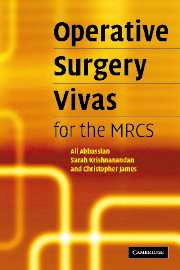Book contents
- Frontmatter
- Contents
- Preface
- 1 The elective repair of an abdominal aortic aneurysm
- 2 Adrenalectomy
- 3 Amputation (below knee)
- 4 Anorectal abscesses, fistulae and pilonidal sinus
- 5 Appendicectomy
- 6 Principles of bowel anastomosis
- 7 Breast surgery
- 8 Carotid endarterectomy
- 9 Carpal tunnel decompression
- 10 Central venous cannulation
- 11 Cholecystectomy (laparoscopic)
- 12 Circumcision
- 13 Colles' fracture (closed reduction of)
- 14 Compound fractures
- 15 Dupuytren's contracture release
- 16 Dynamic hip screw
- 17 Fasciotomy for compartment syndrome
- 18 Femoral embolectomy
- 19 Femoral hernia repair
- 20 Haemorrhoidectomy
- 21 Hip surgery
- 22 Hydrocele repair
- 23 The open repair of an inguinal hernia
- 24 Laparotomy and abdominal incisions
- 25 Oesophago-gastroduodenoscopy
- 26 Orchidectomy
- 27 Parotidectomy
- 28 Perforated peptic ulcer
- 29 Pyloric stenosis and Ramstedt's pyloromyotomy
- 30 Right hemicolectomy
- 31 Skin cover (the reconstructive ladder)
- 32 Spinal procedures
- 33 Splenectomy
- 34 Stomas
- 35 Submandibular gland excision
- 36 Tendon repairs
- 37 Thoracostomy (insertion of a chest drain)
- 38 Thoracotomy
- 39 Thyroidectomy
- 40 Tracheostomy
- 41 Urinary retention and related surgical procedures
- 42 Varicose vein surgery
- 43 Vasectomy
- 44 Zadik's procedure
9 - Carpal tunnel decompression
Published online by Cambridge University Press: 16 October 2009
- Frontmatter
- Contents
- Preface
- 1 The elective repair of an abdominal aortic aneurysm
- 2 Adrenalectomy
- 3 Amputation (below knee)
- 4 Anorectal abscesses, fistulae and pilonidal sinus
- 5 Appendicectomy
- 6 Principles of bowel anastomosis
- 7 Breast surgery
- 8 Carotid endarterectomy
- 9 Carpal tunnel decompression
- 10 Central venous cannulation
- 11 Cholecystectomy (laparoscopic)
- 12 Circumcision
- 13 Colles' fracture (closed reduction of)
- 14 Compound fractures
- 15 Dupuytren's contracture release
- 16 Dynamic hip screw
- 17 Fasciotomy for compartment syndrome
- 18 Femoral embolectomy
- 19 Femoral hernia repair
- 20 Haemorrhoidectomy
- 21 Hip surgery
- 22 Hydrocele repair
- 23 The open repair of an inguinal hernia
- 24 Laparotomy and abdominal incisions
- 25 Oesophago-gastroduodenoscopy
- 26 Orchidectomy
- 27 Parotidectomy
- 28 Perforated peptic ulcer
- 29 Pyloric stenosis and Ramstedt's pyloromyotomy
- 30 Right hemicolectomy
- 31 Skin cover (the reconstructive ladder)
- 32 Spinal procedures
- 33 Splenectomy
- 34 Stomas
- 35 Submandibular gland excision
- 36 Tendon repairs
- 37 Thoracostomy (insertion of a chest drain)
- 38 Thoracotomy
- 39 Thyroidectomy
- 40 Tracheostomy
- 41 Urinary retention and related surgical procedures
- 42 Varicose vein surgery
- 43 Vasectomy
- 44 Zadik's procedure
Summary
What is carpal tunnel syndrome (CTS)?
CTS is defined as median nerve compression neuropathy at the carpal tunnel. This is a fibro-osseous canal, the roof of which is formed by the flexor retinaculum and the floor by the carpal bones and their joining ligaments.
List some of the causes of this condition
Most cases are idiopathic, however fluid retention as seen in pregnancy can cause the syndrome. Other associated conditions include: rheumatoid arthritis, diabetes, hypothyroidism, acromegaly, amyloid, wrist ganglions and fractures.
What non-surgical options are there in the treatment of CTS?
Splinting, in particular at nighttime, or injection of corticosteroids into the carpal tunnel.
How do you perform a carpal tunnel decompression (CTD)?
Pre-operatively The diagnosis is confirmed clinically and/or with nerve conduction studies. Informed consent is taken, explaining the risks and benefits of the procedure. A choice of local anaesthetic versus general anaesthetic depends on patient's condition and surgeon preference. A tourniquet may be used.
Position This is supine with the affected arm on a supporting table. The hand and forearm are then prepared and draped.
Procedure A 4–6-cm palmar incision is made ulnar to the midline to avoid damage to the sensory palmar branch of the median nerve. The proximal extent will be the distal crease of the wrist. This is made through skin, subcutaneous fat and palmar/ forearm fascia. Flexor retinaculum is then identified and incised along the line of the incision (directing the distal extension of this incision in an ulnar direction to avoid the recurrent motor branch of the median nerve). The median nerve may be protected using a Macdonald retractor.
Closure The skin closure is then undertaken after adequate haemostasis is achieved.
- Type
- Chapter
- Information
- Operative Surgery Vivas for the MRCS , pp. 31 - 34Publisher: Cambridge University PressPrint publication year: 2006



